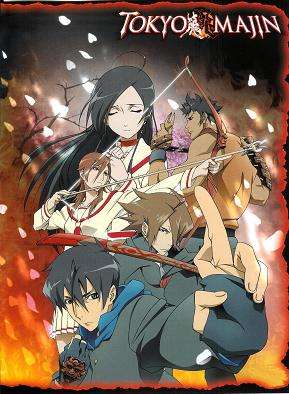Tokyo Majin

Tokyo Majin (full Japanese title: Tokyo Majin Gakuen Kenpuchō: Tō) is an anime series loosely based on the Tokyo Majin Gakuen videogame series.
In the nights of Tokyo, mysterious deaths involving the 'Reborn Dead' occur. People that are disappearing at night suddenly reappear during the day as a corpse. Not only that, but as the corpses are sent to the morgue to be autopsied, they disappear again leaving signs showing that they escaped themselves.
To fight these 'Reborn Dead' and to prevent more deaths, mysterious transfer student, Tatsuma Hiyuu, and delinquent student, Kyouichi Houraiji, stay up every night to fight and solve what's causing this. Along with the rest of their group, who all have supernatural powers, they soon realize that a greater threat, which involves even more powerful demons, is near...
- Anime Hair - Kyouichi and Raito
- The Anime of the Game
- Bonus Episode - The last episode is a bonus episode that explores Tatsuma and Daigo's backstory.
- Defeat Means "Friendship" - The Sumida Shitennou whom Kyouichi and Tatsuma defeat in the first episode end up as Kyouichi's lackeys.
- Delinquents - A lot of them, including Kyouichi. Yuuya used to be one, too.
- Five-Man Band
- The Hero: Tatsuma
- The Lancer: Kyouichi
- The Smart Guy: Komaki (though emotionally volatile; can sometimes be seen as The Chick).
- The Big Guy: Yuuya (Though can also be The Smart Guy at times)
- The Chick: Aoi
- The Sixth Ranger: Raito, Hisui
- Japanese Honorifics - ...and lack of them, as evidenced by Aoi and Kyouichi. They start out calling each other "Misato" and Houraiji-kun," somewhere along the line they graduate to "Aoi" and "Kyouichi-kun" and by the end it's "Aoi" and "Kyouichi."
- The Thing That Goes Doink - Lampshaded in the drama CD, where Tatsuma and Komaki even refer to the one in Aoi's house along these lines.
- World of Badass: It got dialed back a bit after the first episode, but it's there. The first episode features the five superpowered main characters, but there's also random Triad guys with improbable weapons and Feng Shui magic (not that it saves them from the corpse puppeteer) and the bullies at school do crazy moves like spitting out nails at high speed onto a spinning bat to form a nail-bat. Even the Intrepid Reporter girl has ninja-like hiding skills to ambush people she's investigating.
- Combination Attack - Every character that joins you, including Tatsuma, has at least one combination attack with one or more characters.
- Gay Option - Rather like the Summon Night series the game's protagonist can end up with any of the 20+ characters that join him whether they be male or female. Granted most of the male character's endings are platonic but there are subtle underlying hints with some. Special mention must be made for Kyouichi who outright states that he likes the protagonist in his ending - he is also the only male character that the protagonist can date at Christmas.
- Ho Yay - Mainly between either Tatsuma (Protagonist)/Kyouichi or Kyouichi/Moroha. This also ties into the anime which shocks many of the western fans as they aren't aware that it originally started in the games and was most likely subtly hinted at in the anime as a nod to the game.
- Japanese Honorifics - ...and lack of them, as each character that joins the player can use one of up to four different ways to call the player depending on how high their relationship value with the player is.
- Loads and Loads of Characters - In total 25 characters join the main hero, Tatsuma, and all of them have endings not to mention the many supporting characters some of whom also have endings. Then there are all the villains not to mention the different characters in the sequel, Gehouchou (all of whom are the ancestors of the main characters in the Kenpuuchou game) as well as the spin-off games and dramas.
- Multiple Endings - Slightly averted in that the actual game's storyline is fairly linear but there are multiple endings with the characters.
- No Export for You - To date none of the games have been licensed.
- Relationship Values - Determines which character Tatsuma will end up with. One of the rarer cases of the relationship values being seen too if you are playing the DS version of the game (after unlocking the Omake mode) or the Oboro-Kiten version of the original game.
- Story to Gameplay Ratio - Skewed very, very far on the 'story' side, to the point where you could almost call it a visual novel.
- Turn-Based Strategy